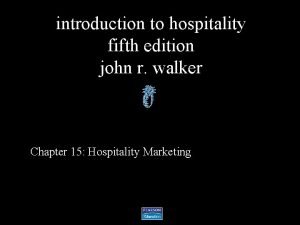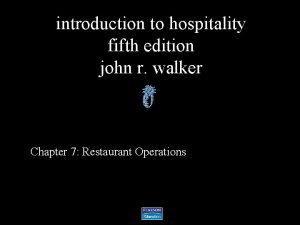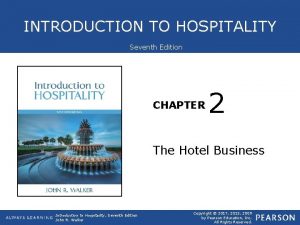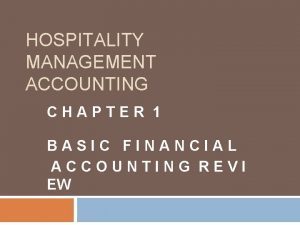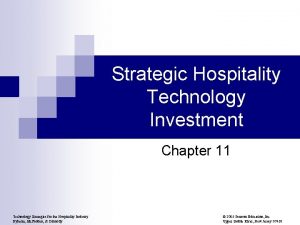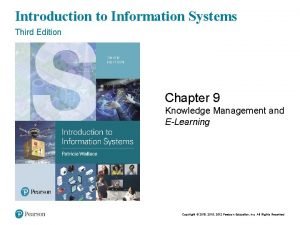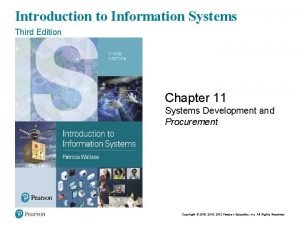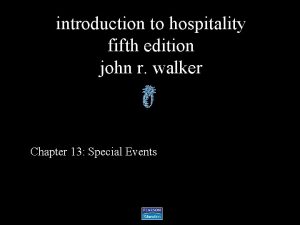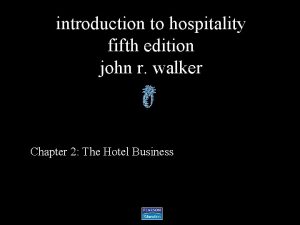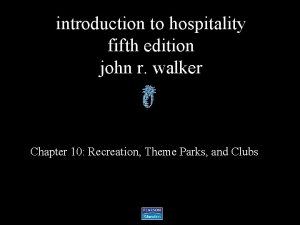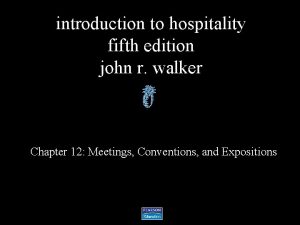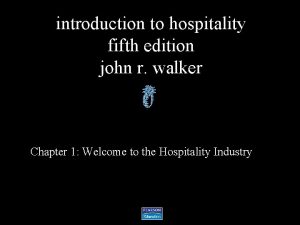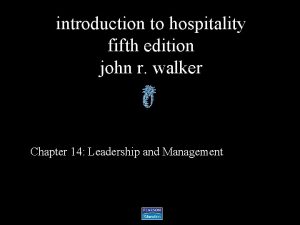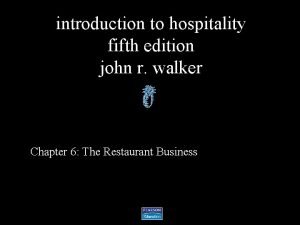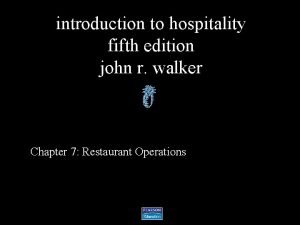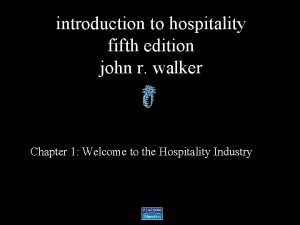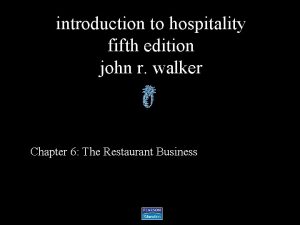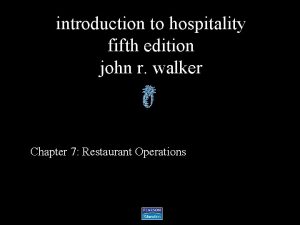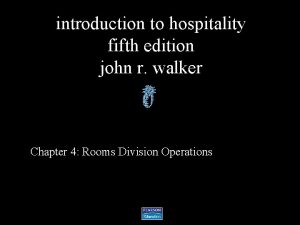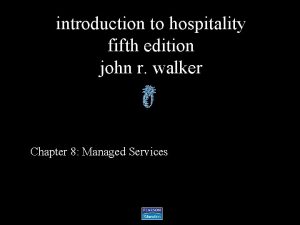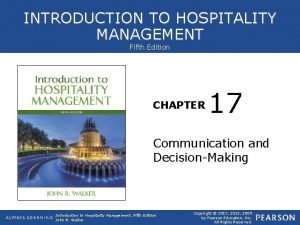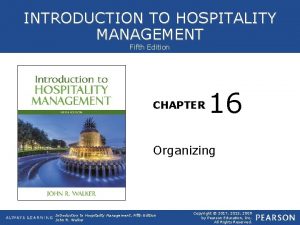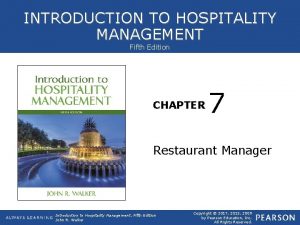introduction to hospitality fifth edition john r walker































- Slides: 31

introduction to hospitality fifth edition john r. walker Chapter 7: Restaurant Operations

Chapter 7 Restaurant Operations • • • Front of the House Operations Restaurant Forecasting Types of Restaurant Service Suggestive Selling Restaurant Systems Back of the House Operations Food Production Kitchen Layout Production Cost Control Trends Introduction to Hospitality Fifth Edition John Walker Copyright © 2009 by Pearson Education, Inc. Upper Saddle River, New Jersey 07458 All rights reserved.

Front of the House • Includes anyone with guest contact from the hostess to the bus person • Curbside appeal: Keeping the restaurant looking attractive and welcoming Introduction to Hospitality Fifth Edition John Walker Copyright © 2009 by Pearson Education, Inc. Upper Saddle River, New Jersey 07458 All rights reserved.

Figure 7 -1 Restaurant Organizational Chart Introduction to Hospitality Fifth Edition John Walker Copyright © 2009 by Pearson Education, Inc. Upper Saddle River, New Jersey 07458 All rights reserved.

Front of the House • The hostess, host, or greeter is responsible for greeting the guests and the rotation of arriving guests among sections or stations • Servers introduce themselves and offer a variety of beverages and/or specials, and invite guests to select from the menu – This is known as suggestive selling Introduction to Hospitality Fifth Edition John Walker Copyright © 2009 by Pearson Education, Inc. Upper Saddle River, New Jersey 07458 All rights reserved.

Restaurant Forecasting • Formulating a budget that projects sales and costs for a year on a weekly and monthly basis • Forecasting restaurant sales has 2 components: Guest counts or covers and the average guest check • Guest counts or covers: The number of guests patronizing the restaurant over a given time period • Average guest check: Calculated by dividing total sales by the number of guests Introduction to Hospitality Fifth Edition John Walker Copyright © 2009 by Pearson Education, Inc. Upper Saddle River, New Jersey 07458 All rights reserved.

Types of Restaurant Service • American Service: Food is placed onto plates in the kitchen, carried into the dining room, and served to guests – Restaurants in the United States, Canada, and many other parts of the world all use American service Introduction to Hospitality Fifth Edition John Walker Copyright © 2009 by Pearson Education, Inc. Upper Saddle River, New Jersey 07458 All rights reserved.

Suggestive Selling • Potent weapon in the effort to increase food and beverage sales • Many restaurateurs cannot think of a better, more effective, and easier way to boost profit margins • The objective here is to turn servers into sellers – On a hot day, for example, servers can suggest frozen margaritas or daiquiris before going on to describe the drink specials Introduction to Hospitality Fifth Edition John Walker Copyright © 2009 by Pearson Education, Inc. Upper Saddle River, New Jersey 07458 All rights reserved.

Front-of-the-House Restaurant Systems • Point-of-sale (POS) systems: – Used to track food and beverage charges and other retail charges that may occur at a hotel or restaurant • Kitchen Display Systems: – Printers in the kitchen are replaced with video monitors and presents orders to kitchen associates along with information on how long orders are taking to be prepared • Guest Services Solutions: – Applications that are designed to help a restaurateur develop a dining relationship with guests – Applications include a frequent-diner management program, delivery management with caller ID interface, and guest accounts receivable to manage home accounts and gift certificate management Introduction to Hospitality Fifth Edition John Walker Copyright © 2009 by Pearson Education, Inc. Upper Saddle River, New Jersey 07458 All rights reserved.

Back-of-the-House Restaurant Systems • Includes inventory control, food costing, labor management, and financial reporting features • Wireless POS Systems: – Allows the servers to use a handheld personal digital assistant to send orders to the kitchen • Labor Management: – Includes a human resources module to track hiring, employee personal information, vacation, I-9 status, security privileges, tax status, availability, and any other information pertinent to employees working at a restaurant Introduction to Hospitality Fifth Edition John Walker Copyright © 2009 by Pearson Education, Inc. Upper Saddle River, New Jersey 07458 All rights reserved.

Back-of-the-House Restaurant Systems • Financial Reporting: – Posts data into a relational database located on the central server – The restaurant manager uses these data for reporting and decision making, profit and loss reports, budget variances, end-of-day reports, and other financial reports are generated • Personal Digital Assistants: – Help hospitality businesses stay effective and efficient by improving time management and helping with faster service Introduction to Hospitality Fifth Edition John Walker Copyright © 2009 by Pearson Education, Inc. Upper Saddle River, New Jersey 07458 All rights reserved.

Back of the House • • Purchasing Receiving Storing and issuing Food production Stewarding Budgeting Accounting and control Introduction to Hospitality Fifth Edition John Walker Copyright © 2009 by Pearson Education, Inc. Upper Saddle River, New Jersey 07458 All rights reserved.

Food Production • Based on expected volume of business • The sales from the previous year gives a good indication of the expected volume and a breakdown of the number of sales for each menu item • The kitchen manager checks the head line cook’s order, which will bring the prep area up to the par stock for prepared items • Prep work is done prior to service times Introduction to Hospitality Fifth Edition John Walker Copyright © 2009 by Pearson Education, Inc. Upper Saddle River, New Jersey 07458 All rights reserved.

Kitchen Layout • The cooking line is the most important part • The size of the kitchen and its equipment are designed according to the sales forecast for the restaurant and the menu • The kitchen is also set up according to what the customers prefer and order most frequently Introduction to Hospitality Fifth Edition John Walker Copyright © 2009 by Pearson Education, Inc. Upper Saddle River, New Jersey 07458 All rights reserved.

Kitchen/Food Production • Staffing and Scheduling: Crucial for the successful running of a kitchen • Training and Development: Implementing a comprehensive training program is vital in the kitchen, due to a high turnover rate Introduction to Hospitality Fifth Edition John Walker Copyright © 2009 by Pearson Education, Inc. Upper Saddle River, New Jersey 07458 All rights reserved.

Kitchen/Food Production • Production Procedures: Relates directly to the recipes on the menu and amount of product on hand to produce the menu • Production sheets: – Count the product on hand (par levels). – Determine production level. – Determine actual sales. • Key to consistency and quality of food Introduction to Hospitality Fifth Edition John Walker Copyright © 2009 by Pearson Education, Inc. Upper Saddle River, New Jersey 07458 All rights reserved.

Kitchen/Food Production • Management involvement and followup: – Management should know first-hand what is going on in the back of the house – As management spends more time in the kitchen, more knowledge is gained, more confidence is acquired, and more respect is earned Introduction to Hospitality Fifth Edition John Walker Copyright © 2009 by Pearson Education, Inc. Upper Saddle River, New Jersey 07458 All rights reserved.

Employee Recognition • An extremely important aspect of back-of-the-house management • Recognizing employees for their efforts creates a positive work environment that motivates the staff to excel and to ultimately produce consistently better-quality food for the guests Introduction to Hospitality Fifth Edition John Walker Copyright © 2009 by Pearson Education, Inc. Upper Saddle River, New Jersey 07458 All rights reserved.

Purchasing • Restaurant operators set up purchasing systems that determine the following: – Use of standards (product specs) – System of control for theft and loss – Par stock and reorder points – Who will do the purchasing? – Who will handle receiving, storage, and issuing? Introduction to Hospitality Fifth Edition John Walker Copyright © 2009 by Pearson Education, Inc. Upper Saddle River, New Jersey 07458 All rights reserved.

Figure 7 -3 Food Cost Control Process Introduction to Hospitality Fifth Edition John Walker Copyright © 2009 by Pearson Education, Inc. Upper Saddle River, New Jersey 07458 All rights reserved.

Purchasing • Product specification: Established standards for each product • Par Stock: The stock level of a product that must be on hand at all times • Purchase order: An order to purchase a certain quantity of an item at a specific price—comes as a result of the product specification Introduction to Hospitality Fifth Edition John Walker Copyright © 2009 by Pearson Education, Inc. Upper Saddle River, New Jersey 07458 All rights reserved.

Receiving, Storing, and Issuing • The purpose of receiving is to ensure the quantity, quality, and price are exactly as ordered • Items should only be issued from the stores on an authorized requisition, signed by the appropriate person • No inventory is kept in the production area and there is no access to the stores Introduction to Hospitality Fifth Edition John Walker Copyright © 2009 by Pearson Education, Inc. Upper Saddle River, New Jersey 07458 All rights reserved.

The First In–First Out System • All items that enter the stores should have a date stamp and be rotated using the first in–first out (FIFO) system • Placing the most recent purchases in rotation behind previous purchases Introduction to Hospitality Fifth Edition John Walker Copyright © 2009 by Pearson Education, Inc. Upper Saddle River, New Jersey 07458 All rights reserved.

Budgeting • Fixed costs are constant regardless of the volume of business – Fixed costs are rent/lease payments, interest, and depreciation • Variable costs fluctuate with the volume of business – Variable costs include controllable expenses such as payroll, benefits, direct operating expense, music and entertainment, marketing and promotion, energy and utility, administrative, and repairs and maintenance Introduction to Hospitality Fifth Edition John Walker Copyright © 2009 by Pearson Education, Inc. Upper Saddle River, New Jersey 07458 All rights reserved.

Restaurant Accounting • Uniform system of accounts for restaurants outlines a standard classification and presentation of operating results • A balance sheet reflects how the assets and liabilities relate to the owner’s equity at a particular moment in time • Once a sales forecast has been completed, the costs of servicing those sales are budgeted on an income statement (see next slide) Introduction to Hospitality Fifth Edition John Walker Copyright © 2009 by Pearson Education, Inc. Upper Saddle River, New Jersey 07458 All rights reserved.

I. Sales A. Food B. Beverage C. Other Total Sales II. Cost of Sales A. Food B. Beverage C. Others Total Cost of Sales III. Gross Profit A. Other Income Total Income IV. Controllable Expenses A. Salaries & Wages B. Operating Expenses, etc. Total Controllable Expenses Rent, Interest, Depreciation, etc. V. Net Income Before Taxes A. Income Taxes Net Income Introduction to Hospitality Fifth Edition John Walker SAMPLE INCOME STATEMENT Copyright © 2009 by Pearson Education, Inc. Upper Saddle River, New Jersey 07458 All rights reserved.

Restaurant Accounting • Operating ratios are industry norms that are applicable to each segment of the industry – Food cost percentage (cost/sales × 100 = food cost percentage) – Contribution margin (difference between the cost of the item and sale price) – Labor cost percentage (salaries and wages of employees, employee benefits, and their training) – Prime cost (combined food and labor costs) – Beverage cost percentage (calculated like the food cost percentage) Introduction to Hospitality Fifth Edition John Walker Copyright © 2009 by Pearson Education, Inc. Upper Saddle River, New Jersey 07458 All rights reserved.

Lease and Controllable Expenses • Lease Costs should not be more than 5 -8% of sales – Most leases are triple net—the lessee must pay for all alterations, insurance, utilities, and possible commercial fees (e. g. , landscaping or parking upkeep) • Controllable Expenses: All the expenses over which management and ownership have control – Salaries and wages (payroll) and related benefits; direct operating expenses such as music and entertainment; marketing, including sales, advertising, public relations, and promotions; heat, light, and power; administrative and general expenses; repairs and maintenance Introduction to Hospitality Fifth Edition John Walker Copyright © 2009 by Pearson Education, Inc. Upper Saddle River, New Jersey 07458 All rights reserved.

Restaurant Manager Job Analysis • The National Restaurant Association (NRA) has formulated an analysis of the foodservice manager’s job by functional areas and tasks—this follows a natural sequence of functional areas from human resources to sanitation and safety (see text) Introduction to Hospitality Fifth Edition John Walker Copyright © 2009 by Pearson Education, Inc. Upper Saddle River, New Jersey 07458 All rights reserved.

Trends • • • More flavorful food Increased take-out meals Increased food safety and sanitation Guests becoming more sophisticated More food court restaurants Steak houses becoming more popular Segments splitting into tiers Twin and multi-restaurant locations Quick-service restaurants in convenience stores • Difficulty in finding good employees Introduction to Hospitality Fifth Edition John Walker Copyright © 2009 by Pearson Education, Inc. Upper Saddle River, New Jersey 07458 All rights reserved.

The End Introduction to Hospitality Fifth Edition John Walker Copyright © 2009 by Pearson Education, Inc. Upper Saddle River, New Jersey 07458 All rights reserved.
 Introduction to hospitality 7th edition
Introduction to hospitality 7th edition Tourism the business of hospitality and travel 5th edition
Tourism the business of hospitality and travel 5th edition John r walker introduction to hospitality management
John r walker introduction to hospitality management Introduction to hospitality 7th edition
Introduction to hospitality 7th edition Introduction to hospitality 7th edition
Introduction to hospitality 7th edition Principles of marketing fifth european edition
Principles of marketing fifth european edition Schachter singer theory
Schachter singer theory Fundamentals of corporate finance fifth edition
Fundamentals of corporate finance fifth edition Democritus atomic model diagram
Democritus atomic model diagram Molecular biology
Molecular biology Molecular biology of the cell fifth edition
Molecular biology of the cell fifth edition Human anatomy fifth edition
Human anatomy fifth edition Human anatomy fifth edition
Human anatomy fifth edition Marketing for hospitality and tourism 7th edition ppt
Marketing for hospitality and tourism 7th edition ppt Tourism and hospitality marketing
Tourism and hospitality marketing Hospitality management accounting 9th edition answer key
Hospitality management accounting 9th edition answer key Using mis (10th edition) 10th edition
Using mis (10th edition) 10th edition Zulily case study
Zulily case study Introduction to strategic hospitality technology investment
Introduction to strategic hospitality technology investment Tourism industry definition
Tourism industry definition Introduction to hospitality marketing
Introduction to hospitality marketing Marketing an introduction 6th canadian edition
Marketing an introduction 6th canadian edition Introduction to teaching
Introduction to teaching Introduction to sociology 9th edition
Introduction to sociology 9th edition Introduction to radar systems skolnik 3rd edition pdf
Introduction to radar systems skolnik 3rd edition pdf Introduction to information systems 6th edition
Introduction to information systems 6th edition Fundamentals of information systems chapter 1
Fundamentals of information systems chapter 1 Microbiology an introduction 9th edition
Microbiology an introduction 9th edition Introduction to information systems 3rd edition
Introduction to information systems 3rd edition Introduction to management information systems 5th edition
Introduction to management information systems 5th edition Introduction to algorithms 2nd ed
Introduction to algorithms 2nd ed Introduction to information systems 3rd edition
Introduction to information systems 3rd edition
